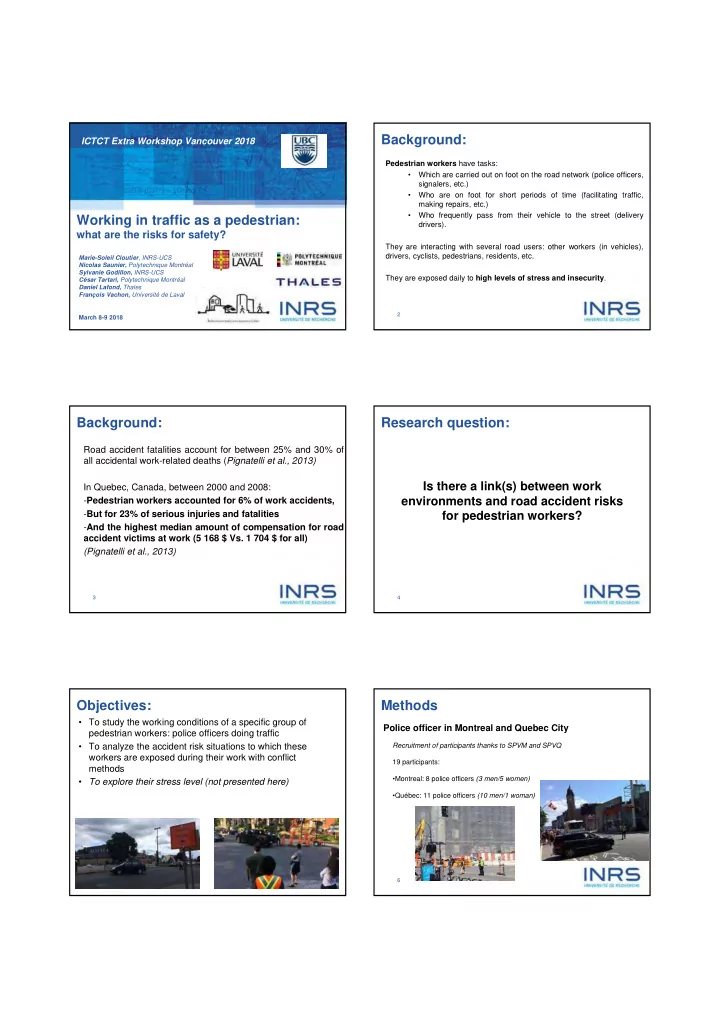

Background: ICTCT Extra Workshop Vancouver 2018 Pedestrian workers have tasks: • Which are carried out on foot on the road network (police officers, signalers, etc.) • Who are on foot for short periods of time (facilitating traffic, making repairs, etc.) • Who frequently pass from their vehicle to the street (delivery Working in traffic as a pedestrian: drivers). what are the risks for safety? They are interacting with several road users: other workers (in vehicles), drivers, cyclists, pedestrians, residents, etc. Marie-Soleil Cloutier , INRS-UCS Nicolas Saunier, Polytechnique Montréal Sylvanie Godillon, INRS-UCS They are exposed daily to high levels of stress and insecurity . César Tartari, Polytechnique Montréal Daniel Lafond, Thales François Vachon, Université de Laval 1 2 March 8-9 2018 Background: Research question: Road accident fatalities account for between 25% and 30% of all accidental work-related deaths ( Pignatelli et al., 2013) Is there a link(s) between work In Quebec, Canada, between 2000 and 2008: environments and road accident risks - Pedestrian workers accounted for 6% of work accidents, - But for 23% of serious injuries and fatalities for pedestrian workers? - And the highest median amount of compensation for road accident victims at work (5 168 $ Vs. 1 704 $ for all) (Pignatelli et al., 2013) 3 4 Objectives: Methods • To study the working conditions of a specific group of Police officer in Montreal and Quebec City pedestrian workers: police officers doing traffic • To analyze the accident risk situations to which these Recruitment of participants thanks to SPVM and SPVQ workers are exposed during their work with conflict 19 participants: methods •Montreal: 8 police officers (3 men/5 women) • To explore their stress level (not presented here) •Québec: 11 police officers (10 men/1 woman) 5 6
Data collection (summer 2017) Methods Video analysis of the trajectories and interactions Video analysis of the trajectories and interactions of road users is done Video recording automatically using a computer vision techniques. An interaction is formed by two users coexisting in the monitored area. Interactions Observation between all users are analyzed according to various safety indicators, in particular: Telescopic pole • Traffic conditions: speed and proximity Tablet survey + + • Time to collision (TTC): the time remaining before two users collide if they continue on their current trajectories Stress felt • use of motion prediction at constant velocity (preliminary) Solar mobile • post-encroachment time (PET): the time between the charger + departure of the first user and the arrival of the second user in Interview the zone where their trajectories intersect During several hours Digital video A few days later… 8 camera 7 Video Analysis Video Analysis (cont.) • Using the open source Traffic Intelligence 1. Feature tracking project 2. Feature grouping • Data preparation 3. Road user classification – metadata and camera parameters 4. Interaction and indicator computation 1 2 correction for grouping distortion 9 10 frame 80 frame 100 11 11 12 12
frame 120 frame 140 13 14 User Median Speed Sample Data: 4 sites, 2 workers C110 C109 Workers\Sites Cluster 1 Cluster 2 P102 C110 28 min C109 30 min P108 C114 24 min C113 28 min 16 C114 C113 Interaction Distance TTC min Filter TTCs below 10 s 17 18
Conclusion PET below 10 s • Work in progress • Large data collection effort requires a lot of data organization and preparation (ongoing) • Speeds are high and workers in the middle of traffic have small TTC and PET with other road users • No link to site typology (for now) 19 20 Limitations Thanks for your listening ! And thanks to our interns who collected data : • The worker is difficult to track L. Barrachina, F. Bataille, R. Jennings, Y. Ishimo, C. automatically Tartari – static for long periods of time or off-duty on sidewalk This presentation is based on • Unclear how accurately we can ongoing research funded by the Robert Sauvé Research Institute on automatically characterize the severity Occupational Health and Safety (IRSST). of worker interactions in the middle of traffic 21 22 TTC and PET 23 (Laureshyn 2010)
Recommend
More recommend